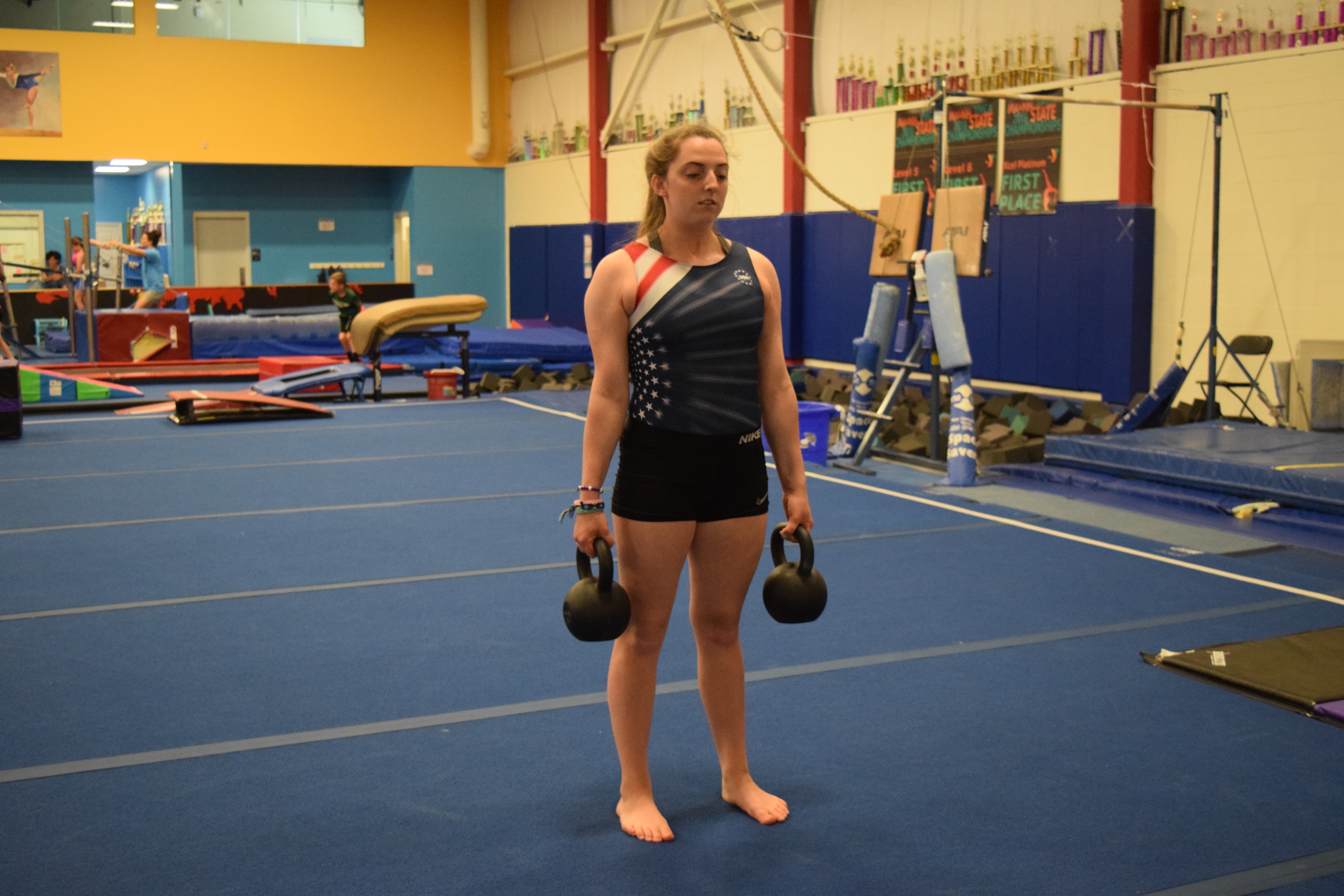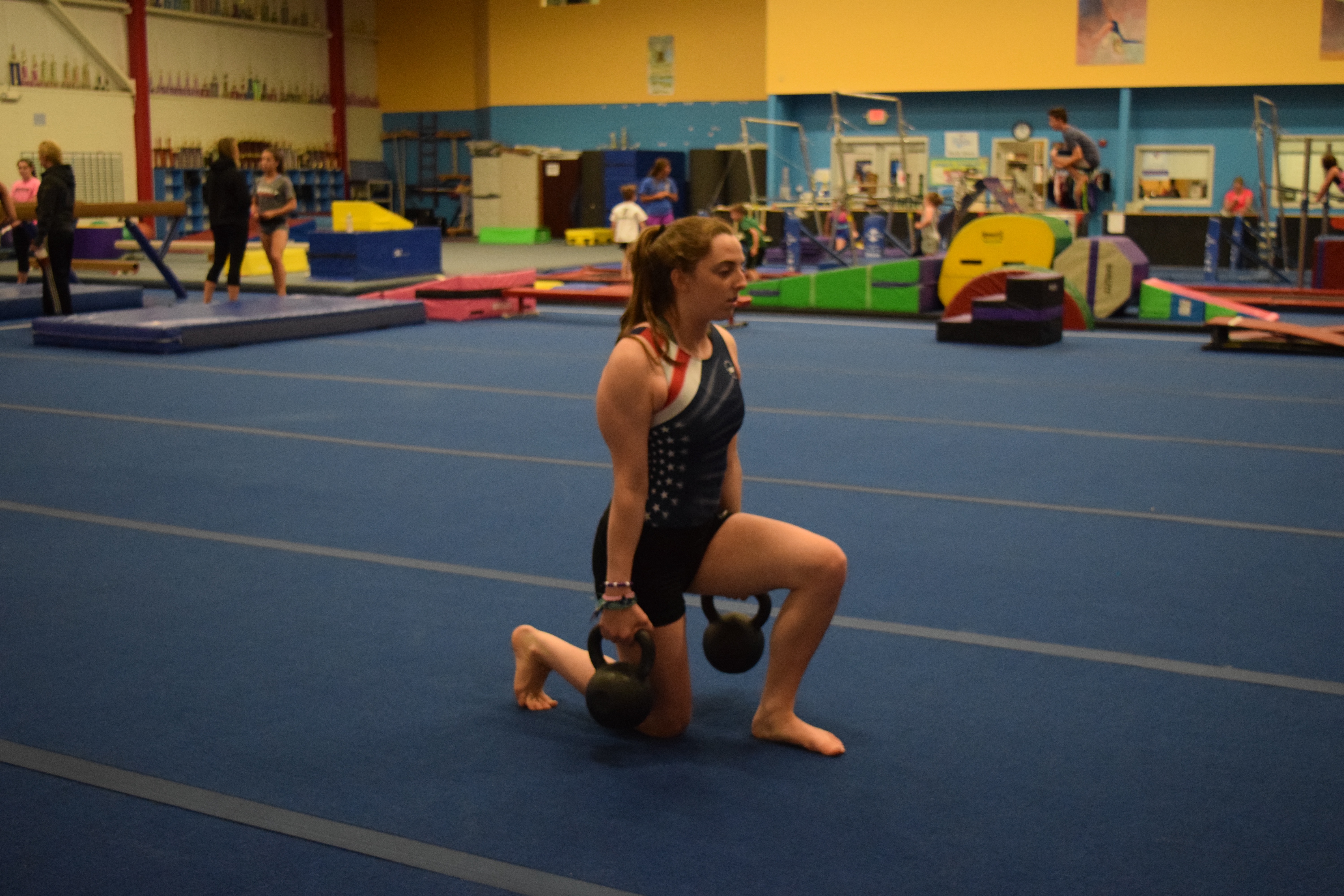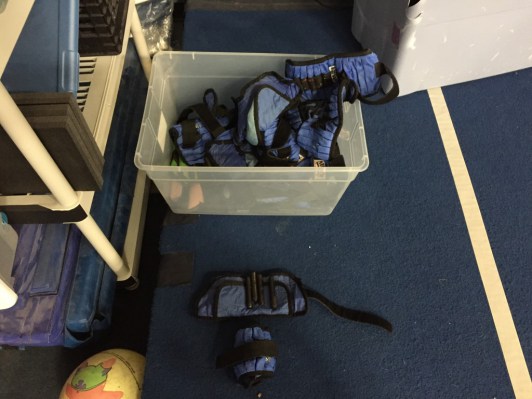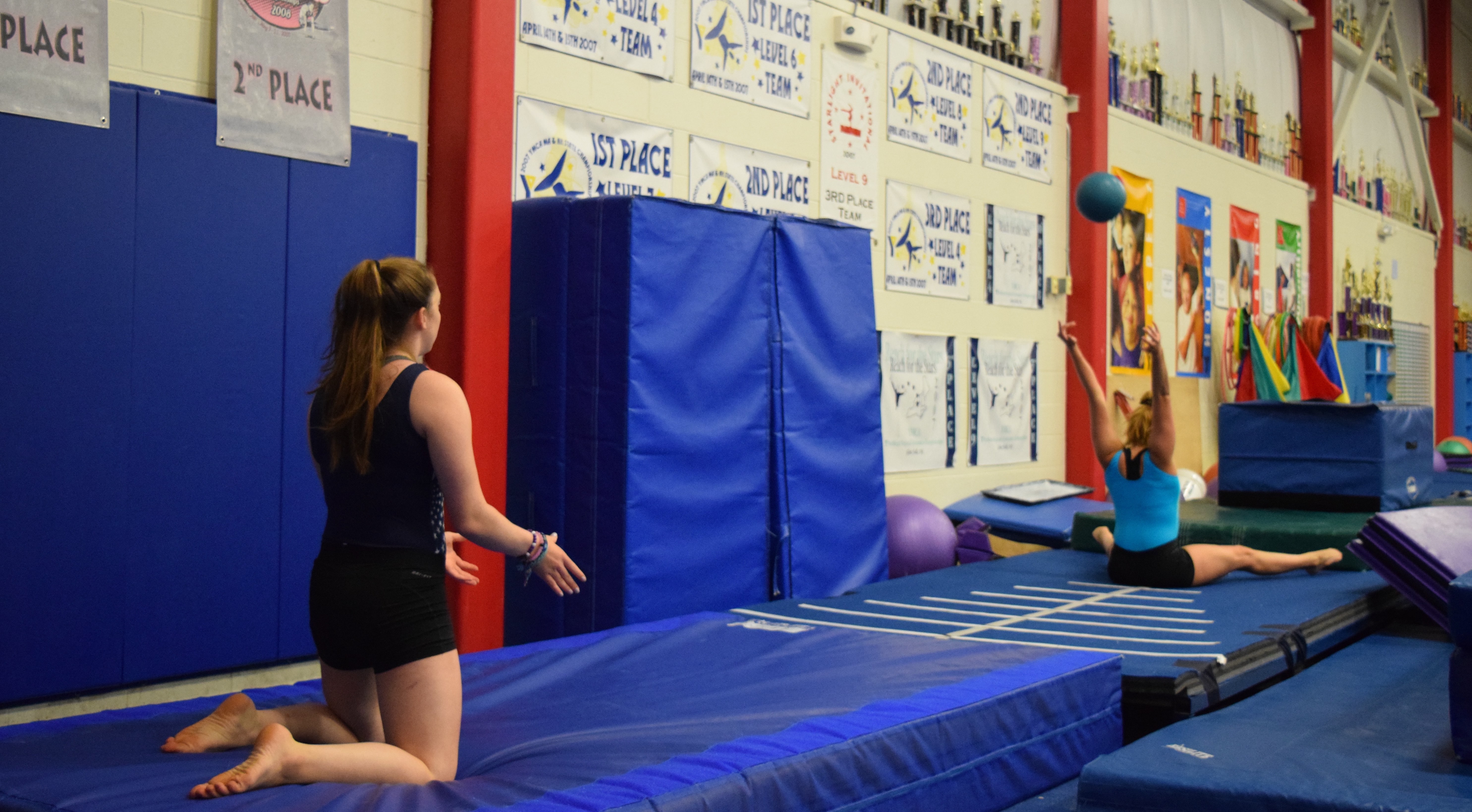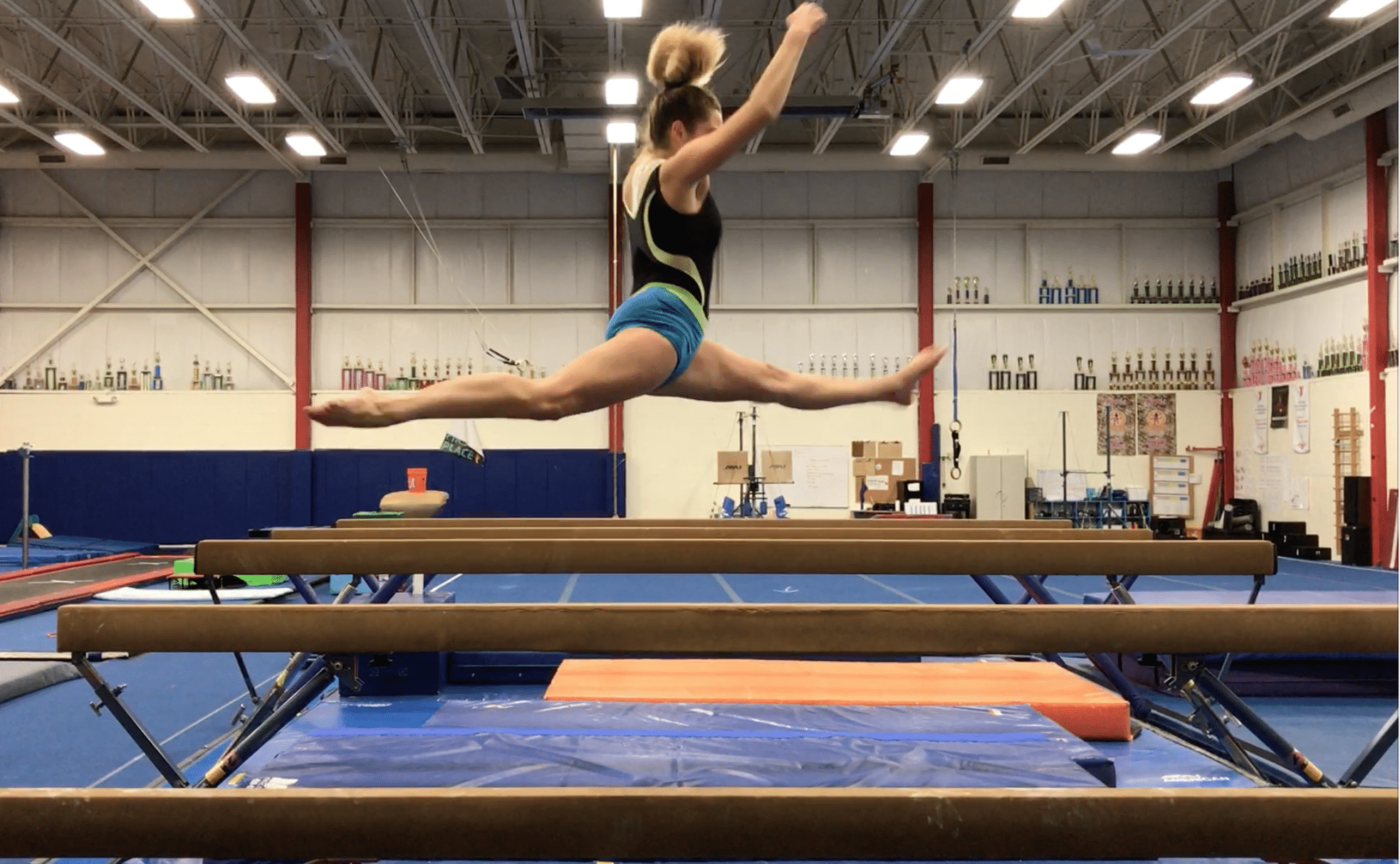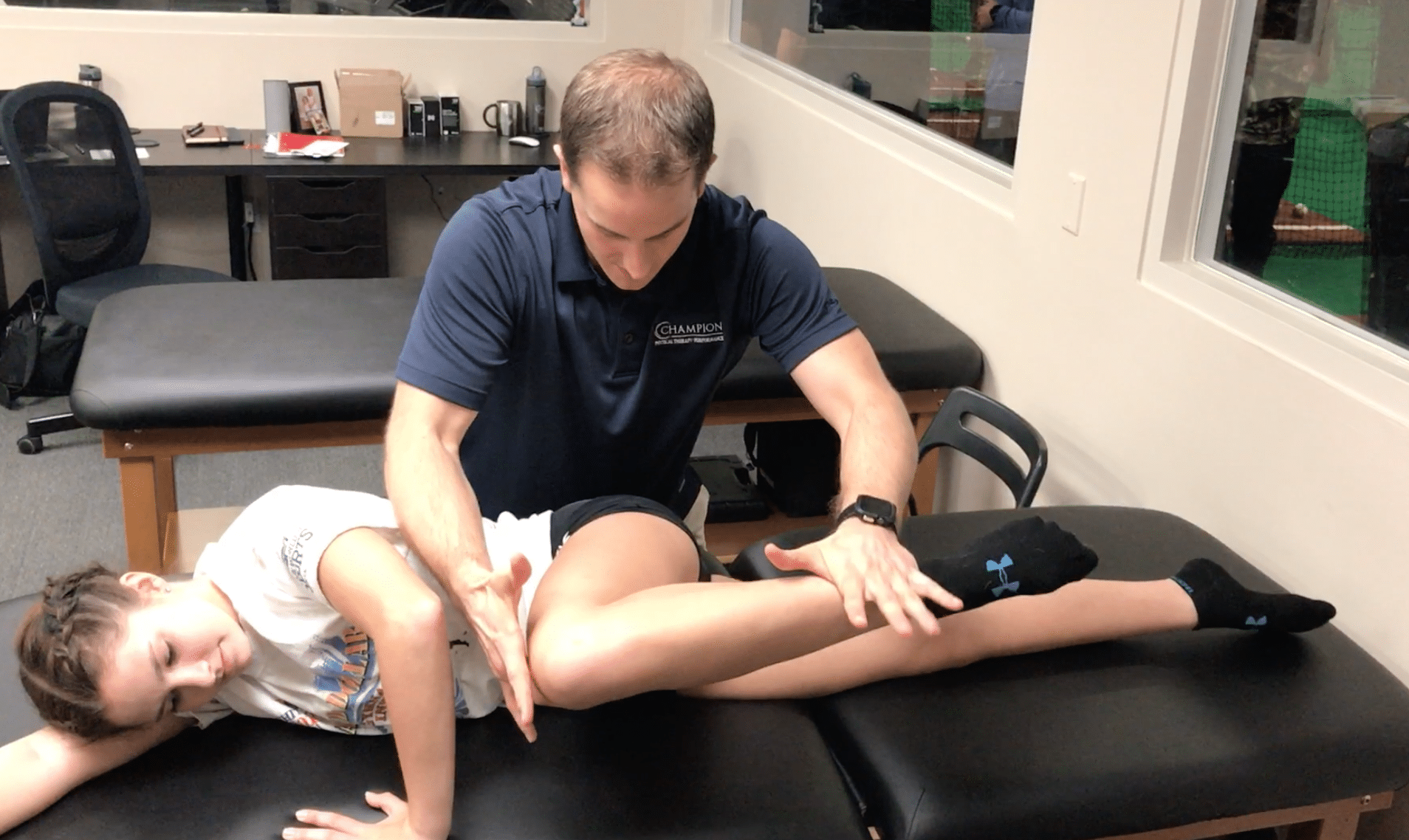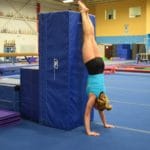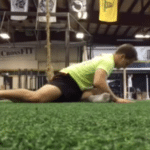Gymnastics and Lifting Weights: Don’t Fear Plates, Kettlebells, and Barbells.
This is an extremely controversial topic in gymnastics: should gymnasts use external weights and barbell work for strength. This “elephant in the room” concept is way too big of an issue to address in one blog post, but I still want to open the door with some thoughts. My opinion is that there are many myths and misunderstandings about the potential role of weight lifting in gymnastics.
Although body weight strength is vital to gymnastics (and we use it daily), I feel solely using body weight approaches for strength does not appropriately prepare a gymnast to handle the high forces seen in gymnastics skills. Without external loading and periodization it is also very hard to increase a gymnast’s power output, which is essential to complete high-level gymnastics skills. By not systematically using weight lifting with gymnasts, we may be missing out on a huge tool to increase performance and reduce the amount of injuries seen in gymnastics.
Before I touch on a few subjects, I wanted to start by showing this video I put together comparing weight lifting and gymnastics skills, which I thought was pretty interesting.
Obviously, there are huge differences also in the surface and conditions the gymnast will perform on (spring floor or spring board) versus the stable surface used in weight training. However, I am trying to illustrate that many of the movement patterns, loading mechanics, and muscles involved are the same. Those few clips show similarities in the triple extension between a vault/floor take off and a power snatch, the overhead impact of tumbling/back tosses on pbars and a close grip snatch, and so on. This concept is also not just applicable to barbell work. Dumbbell work, kettlebells, and other weighted exercises all apply to this concept. Before I dive into it I want to make sure I mention the work of Dr. Bill Sands, Rupert Egan, Dave Picardy, Andy Tysz, and Brian Pickard as many of their thoughts will come through in this post. Here are some things to consider related to the role of weight lifting in gymnastics.
Table of Contents
Misunderstanding 1: Lifting Weights Makes Gymnasts Bulky and Lose Skills
There is a false assumption that by lifting weights a gymnast will automatically become big, bulky, and lose their lean body physique. Many fear that this will then throw their strength to weight ratio off, making them lose gymnastics skills. The reality of the situation is that this thought is very misguided. I think it is rooted in the fact that people hear “weightlifting” only to picture body builders doing bicep curls, or power lifters back squatting ridiculously heavy weight.
Research and literature supports that there are very specific programming methods that must be used to encourage huge amounts of hypertrophy or structural tissue growth. Available research outlines how changes in strength seen from organized weight lifting is largely due to neurological changes first, and not always the growth of new muscle tissue. This is especially true with the beginning stages of strength work. The nervous system first learns to fire more motor units, discharge them at a higher rate, coordinate the kinetic chain, and learns movement efficiency to move more load. It is only through heavy volume and specific programming manipulation will large changes in mass be seen.
With the right coaching, exercises, programming, nutritional guidance, and training habits this fear of muscle mass impacting gymnastics skills can easily be pushed aside. You just have to find and work with the right strength coach. This is why I hand all of our gymnast’s adjunctive weight lifting programming over to Dave Picardy and his staff at TreeHouse Athletics. We work together to compliment each other, but I handle in the gym gymnastics/loading part of it and he handles the adjunctive barbell programming work.
Through periodization the strength progress they see is then converted to power, gymnastics specific skill strength, and built into energy systems training for competition. We work together for a program that balances body weight gymnastics based strength, with safe and progressive weightlifting, and still allows for plenty of time to train gymnastics skills.
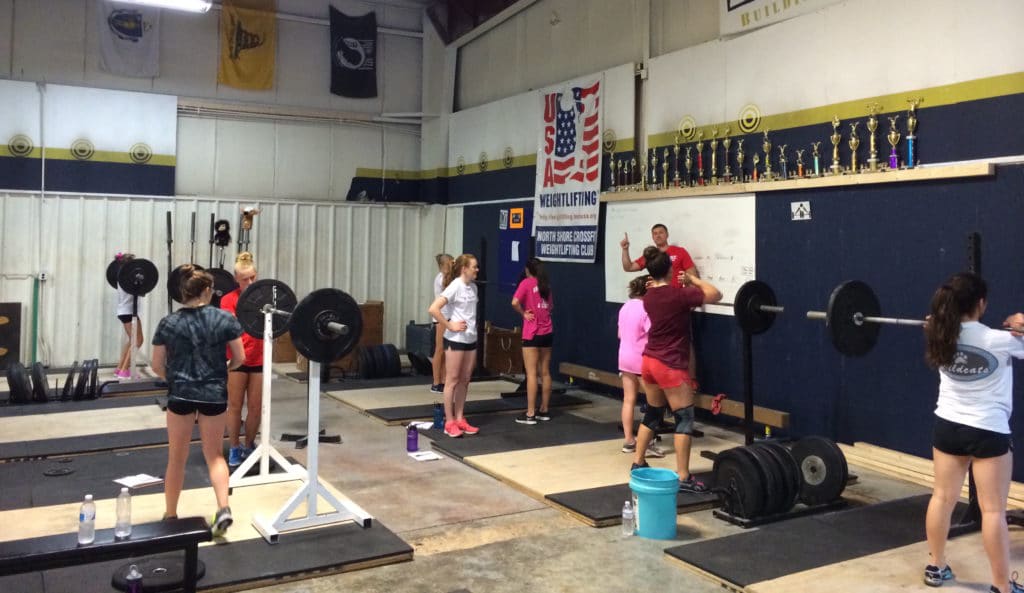
Misunderstanding 2: Lifting Weights Causes Injury
There is another false assumption that using weights is dangerous, and will cause injury especially in younger athletes. First off, the forces in gymnastics are astronomical. To say that loading with weights during strength training is not okay due to safety concerns, but not address the fact that the same gymnast takes 17x her body weight in force hundreds of times per week during tumbling landings is a bit of a double standard. The reality of the situation is that if you lift weights the wrong way, with no programming or systematic plan, and don’t understand technique then yes the risk of injury is high. However, with the proper coaching and programming this can be avoided and injury risk is quite low.
Actually, some research supports that organized strength programs may be one of the most effective methods for injury prevention. When you think practically about it, it makes sense. Injury tends to occur when tissues can’t handle or accept high forces, which causes damage and injury. It’s hard to wrap our head around because we don’t see the high forces during gymnastics skills. However, they are very real and cause big problems if not handled appropriately. I highly suggest people read the Gymnastics Sports Medicine Handbook related to some gymnastics force loading data.
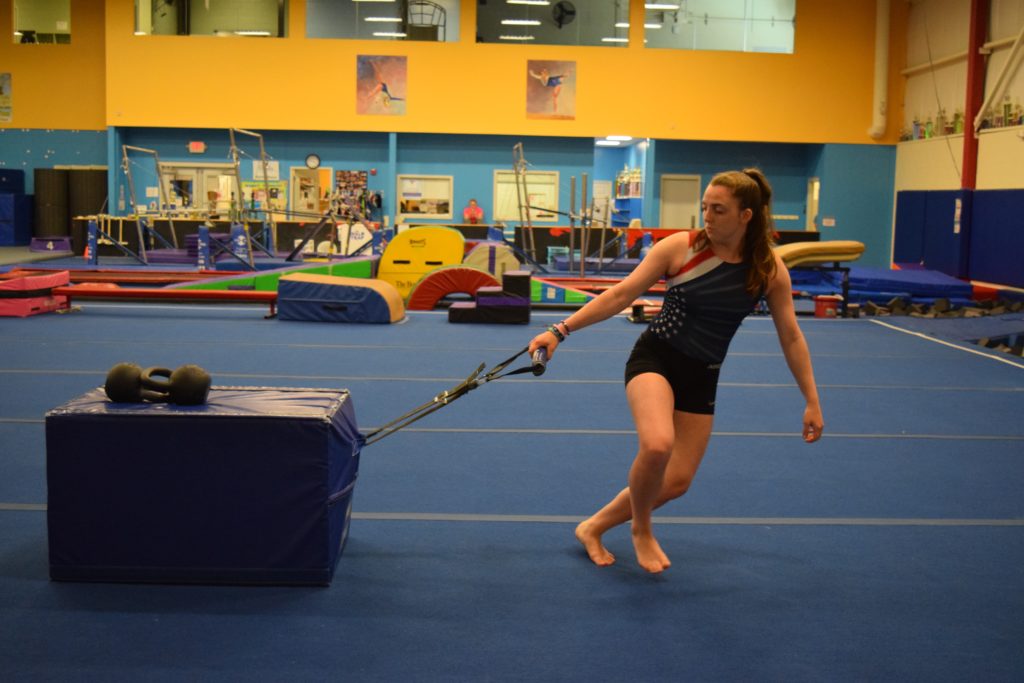
I honestly feel that there are many gymnasts who simply do not possess the strength to handle the forces of gymnastics, and they unfortunately break down to have a very serious injuries. There comes a point where body weight strength or light dumbbells simply aren’t enough to prepare them for insanely high forces of gymnastics skills. This is where adjunctive weight lifting can come into play. Weight lifting and periodization is used to systematically teach the body to handle more force, prepare the tissue for loading, and teach proper movement mechanics as a method of injury prevention.
Inevitably the question about age concerns and a growing athlete come into play. With a younger more developing population, the focus is much more about proper movement patterns and not so much heavier loads. As with anything else, it’s all about proper mechanics and consistency before intensity.
When we add weight to our younger gymnasts in the gym, it is only when they demonstrate sound mechanics and understand what they are doing. If they show flawed technique, they do not get weight. Just as with gymnastics, their goal is more on development and consistency in their movement. If you work with a strength coach who teaches proper movement patterns, understands programming, uses the right exercises, and understands gymnastics, the risk of injury when using weights is significantly reduced.
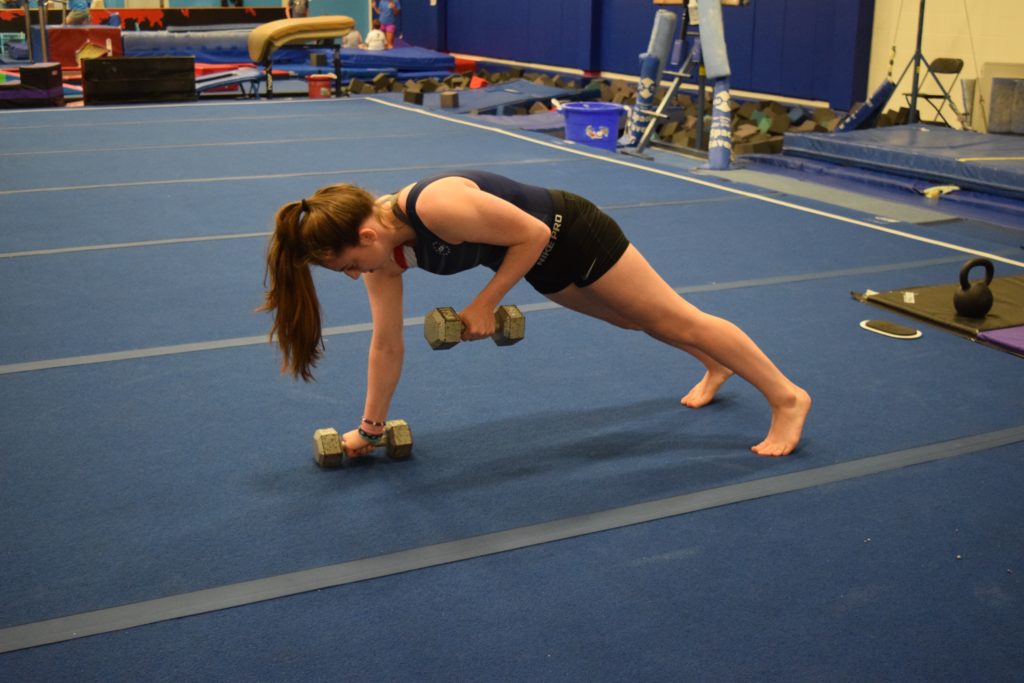
Misunderstanding 3: Lifting Weights Makes Gymnasts Lose Flexibility
A third fear I think the gymnastics community has about the use of loading is that by training with weights a gymnast will loose all of their flexibility. When the correct weight training is used, this also is very misguided. On the contrary, lifting with load in a full range of motion is actually one of the best ways to maintain mobility. This is true because the motion becomes functionally important to the nervous system, and strength is developed throughout their entire range. If you then take this motion and apply it to sports specific gymnastics conditions, it can do wonders for a maintaining a gymnast’s mobility. A combination of barbell work, along with unilateral exercises via kettlebells/dumbbells, and also additional body control drills, are great ways to go about this.
I think the notion of loosing flexibility is based on the inaccurate idea that tissue permanently shortens when we lift weights, and lengthens back out when we do stretching or flexibility work. As I have talked about before, there is a lot more that goes into gaining and keeping range of motion changes. Following lifting workouts with muscular repair, yes there may be temporary reductions in range (as happens with any strength methods). However, with full range of motion exercises, the continuation of mobility work, recovery/nutrition education, and the right programming this myth can again be pushed aside.
Many of our gymnasts have gone through 2 years of lifting experience and didn’t suddenly lose their splits or shoulder mobility because of it. Not to mention I have worked with some pretty strong weight lifting athletes who have better mobility than me. With the right exercise selection and implementation, the gymnastics community shouldn’t worry that their gymnasts will lose all of their mobility by lifting weights.
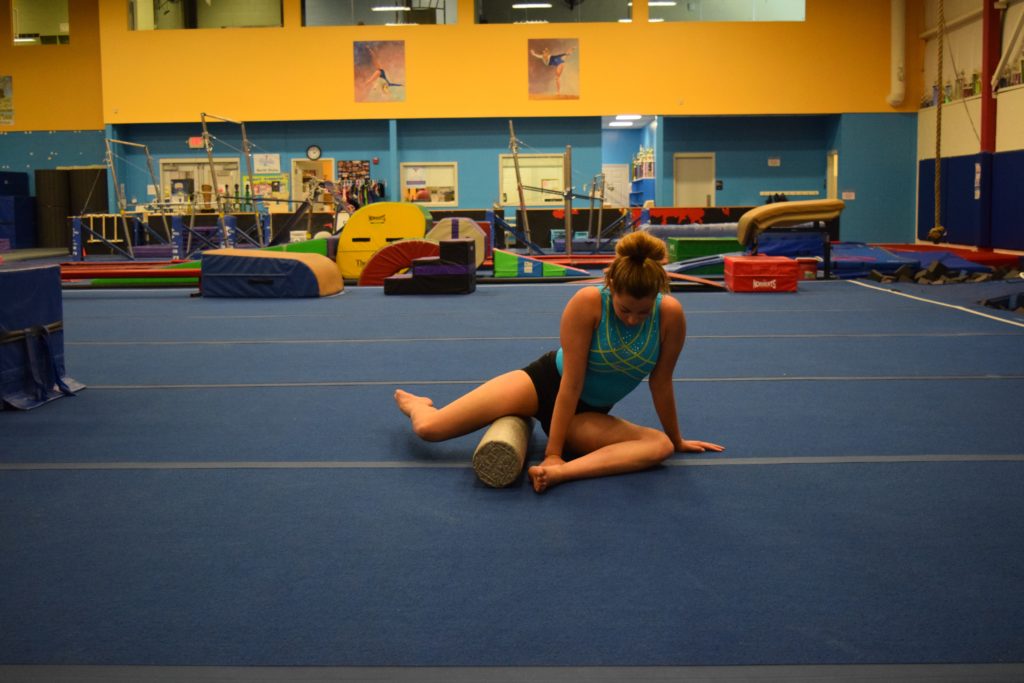
Weightlifting Is Only One Piece To Our Strength Program
Am I saying weights and barbell training should replace traditional gymnastics strength? Absolutely not. Our gymnasts utilize external weights and barbell work in conjunction with regular body weight strength training, gymnastics specific patterns like press handstands/ leg lifts, and still continue to train in many traditional gymnastics ways to get new skills. To summarize I feel there is a huge potential to utilize adjunctive barbell work as a means to,
- Build good movement patterns safely and early that are seen regularly in gymnastics (jumping, landing, squatting, reactive overhead control, traction type loading)
- Develop 360 core bracing and strength strategies that slowly expose the spine to force, so the gymnast can learn to control it and protect their lower back
- Systematically load and adapt a gymnast’s body for common high-force situations like accepting high load during tumbling and dismount landings, high force overhead upper body impact, and high force overhead upper body traction.
- Slowly expose the gymnasts body to stress so it can adapt and get stronger, increasing resistance to force overload injuries that are an epidemic in gymnastics
- Teach the gymnast neurological control and coordination to express higher force during skill work, causing increased power and increased amplitude during skill work
- Help bridge the gap between less force compulsory skills and very high force skills seen in optional gymnastics. I feel the jump between these types of skills and the lack of structural preparation in a gymnasts body is a main driver for sparking overuse injuries.
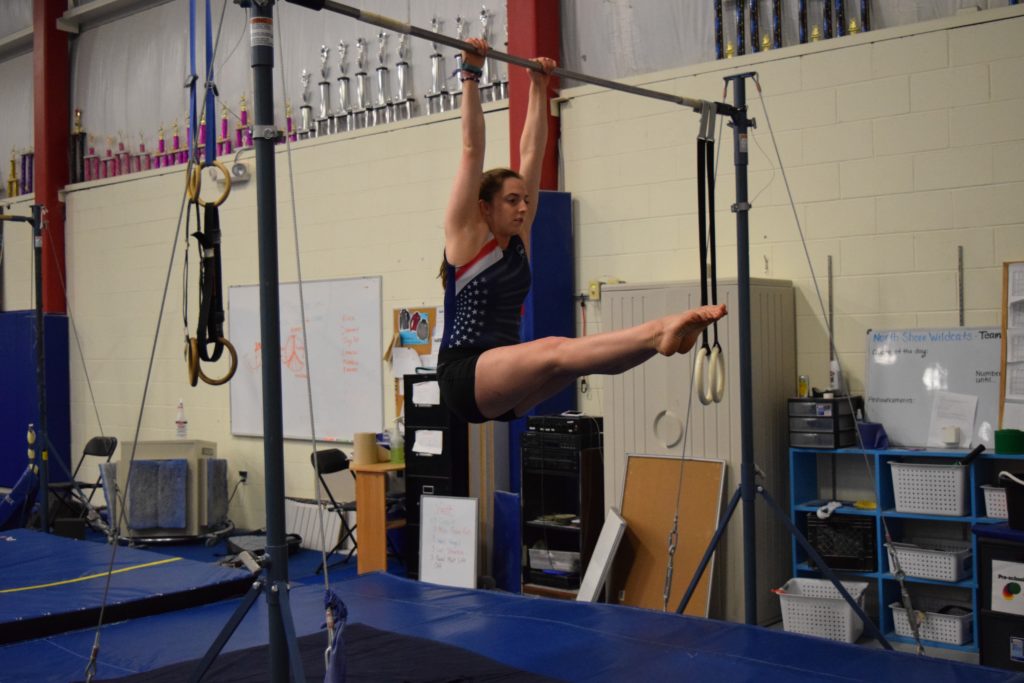
Concluding Thoughts
I am not a formal strength coach, but I have spent a significant amount of time reading and trying to learn more from great strength coaches I know. For gymnastics, I think it comes down to a fear of the unknown, paired with the lack of good collaboration between disciplines, a lack of knowledge about strength/periodization, and unfortunately some amount of coaching egos wanting to have complete control of their strength programs. However, I think this is preventing us from a taking advantage of a major tool to boost performance and drastically reduce injury risk in our gymnasts.
We also have to remember that it must be used at the appropriate time, and in conjunction with a long-term plan. Clearly lifting is not the main focus during pre-competition and routine season, and there will be different roles for various gymnasts. If we can get past these issues and be open to the adjunctive use of weight training I think we will see a huge step forward in the sport of gymnastics both for the potential pool of talented athletes and a reduction in the number of them we sadly loose to injury.
I encourage people to look up and read some of the resources related to strength training including a 2013 review of exercise interventions for injury prevention from BJSM, Dr. Sands paper “Should Female Gymnasts Lift Weights?”, some more of Dr. Sand’s Gymnastics Strength articles, the recent International Olympic Committee Consensus Statement on Youth Athletic Development, Tudor Bompa’s Periodization book that extensively reviews methods of strength training related to sports, and the abundance of other strength & conditioning research available. I also encourage people in the gymnastics world to seek out qualified strength and conditioning coaches to assist them in learning about the science
I also encourage people in the gymnastics world to seek out qualified strength and conditioning coaches to assist them in learning about the science for strength training. Guessing or going on methods that you’re unsure about, especially when it comes to proper form/technique, is not only dangerous but also may leave the gymnasts with untapped potential. That’s all for now, and I hope people found this post interesting. Have a great week!
Dave Tilley DPT, SCS

